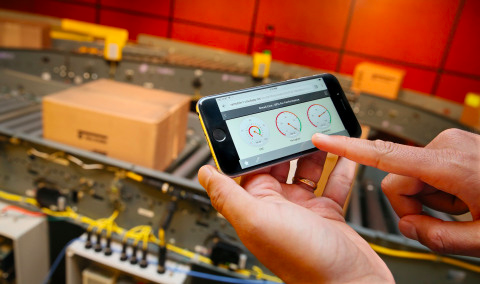
Rockwell Automation–A Software Company?
I put on the pair of magic glasses. Immediately I was transported to a magic land of another reality. I saw things floating in front of me. I could walk around objects and view them from every angle, but I couldn’t touch them.
There was a white dot. I focused on the dot and brought my hand up to eye level forming a fist with fingers on top. Then I opened my fist like a jasmine bud you drop into hot water to make fragrant tea. And a computer screen appeared before my eyes. I raised a finger, pointed to a button, brought my finger down and then back up as if clicking. And a machine started.
No, I had not smoked something. (Although people suspect that in my days at university… well that’s another topic for another day!)
Perhaps you’ve seen the TV ads for the Samsung phone with Virtual Reality (VR) goggles? I was wearing a real product–the Microsoft Hololense. This is Augmented Reality (AR). I could see people walking through the first machine. I could see the actual machine in the second scenario. I controlled the fan speed of the real machine without touching anything. People watching would only see me waving my hand.
Yes, this was last week in Atlanta at Automation Fair sponsored by Rockwell Automation. At a stand called modestly enough The Future of the Connected Enterprise, they showed these working examples of AR in a manufacturing setting.
Innovation
Let’s be honest. In 20 Automation Fairs I’ve attended, I’ve never felt like I’ve seen the bleeding edge of technology. Cool new products? Sure. Rockwell kept advancing with the times. The Logix engine was an advance in the state of the art followed by Studio 5000. But that has been some time ago. This year just felt differently.
First there was a live demo during the media day that included information solutions. Next was the Innovation Zone demo of AR. Finally was a dive into Information Solutions–something initially highlighted by new CEO Blake Moret.
First an admission and some definitions. I stole the headline of the piece from both ControlGlobal and Automation World. I think I saw it in both places on the Web last week. Now the description–Rockwell calls “Software” its software for HMI, programming, and the like. What really has been building is “Information Solutions.” More accurately, the headline should have been, “Rockwell Automation, An Information Solutions and Services Company.”
An Information Solutions Company
 Information Solutions and Process Solutions are headed by the same VP/GM, John Genovesi. Process had been growing for several years, but it seems to have leveled off lately. Information Solutions was front and center featured this year. My industry research this year revealed that IS accounts for the bulk of revenue increases within the “Connected Enterprise” strategy. And that makes sense.
Information Solutions and Process Solutions are headed by the same VP/GM, John Genovesi. Process had been growing for several years, but it seems to have leveled off lately. Information Solutions was front and center featured this year. My industry research this year revealed that IS accounts for the bulk of revenue increases within the “Connected Enterprise” strategy. And that makes sense.
One of the deep-dive interview opportunities offered me this year was the Information Solutions group. Spokesperson Khris Kammer told me that there were four pillars to discuss this year–Scalable MES, Scalable Analytic, Connected Services, and Collaboration/Teams. I’ll have more detail on product releases from the first two. Connected Services was touted by Moret during our interview.
The traditional challenge for MES has been its monolithic nature. If you want MES, you must buy a big chunk. Rockwell has been working on this customer challenge and barrier to entry. Rockwell introduced “suites”, but that did not address the entire problem. Now are “fit-for-purpose” apps–quality, production, performance. Read more below.
Analytics became the domain of data scientists through “Enterprise Manufacturing Intelligence” (EMI) which was a spin-off from enterprise Business Intelligence. Rockwell partners with Microsoft PowerBI, but it also worked on the scalable aspect to bring customers in a little at a time. Built upon existing products Historian and VantagePoint, developers built Analytics for Devices and Analytics for Machines–a cloud-based broader solution. Read more below.
Connected Services blends service in networks, security, and managed services. This has been a growing part of Rockwell’s business and now receives the attention and focus of landing as part of the Connected Enterprise strategy.Collaboration features a Web-based, HTML5 app called TeamOne. The team demonstrated it to media in perhaps the first live demo at a Rockwell keynote. Figuring that pretty much everyone already brings a smart phone to work, this app is IT-friendly and allows chatting, information access, video capability, and more among selected members of a team. These personnel may be in the same area, scattered around a facility, or even remote if necessary.
Scalable Analytics
“Our Connected Enterprise vision has always had analytics and collaboration at its core,” said Genovesi. “As we expand our Information Solutions offerings, a primary goal is to make analytics more approachable and right-sized for the customer. New analytics solutions help our customers move ahead on their Connected Enterprise journey, no matter where they are today.”
The new offerings expand capabilities for analytics across the plant floor for devices, machines and systems, as well as throughout the enterprise. In this approach, analytics are computed and gain context closest to the source of decision at the appropriate level in the architecture to return the highest value – from edge devices to the cloud on a variety of new appliances, devices, and on- or off-premise cloud platforms.
FactoryTalk Analytics for Devices appliance provides health and diagnostic analytics from industrial devices. It crawls your industrial network, discovers your assets and provides analytics by transforming the data generated into preconfigured health and diagnostic dashboards. The system also delivers “action cards” to your smartphone or tablet if a device requires attention.
At the machine level, FactoryTalk Analytics for Machines cloud application provides equipment builders access to performance analytics from deployed systems to help support their customers via the FactoryTalk cloud. For manufacturers, this capability capitalizes on connected technologies to help drive higher availability and output while reducing maintenance costs.
Rockwell Automation now provides a predictive maintenance solution that can predict failures before they happen and generate a maintenance work order to avoid costly downtime.
Scalable MES
Rockwell Automation has released the following applications, with more to come in the future:
FactoryTalk Production Application a scalable MES solution that addresses the challenges associated with enforcing processes in manufacturing. This application integrates with ERP, and tracks the order and recipe parameters necessary for production.
FactoryTalk Quality Application allows manufacturers to easily and efficiently model and enforce their plant’s in-process quality regimens at a scalable rate. Manufacturers can use the Quality application on a project basis and scale up when value is proven.
FactoryTalk Performance Application is a modular application that assists manufacturing companies with factory efficiency and production improvement. By providing visibility into the operations performance, this application allows for lean and continuous improvement, preventive manufacturing, improved asset utilization and operational intelligence.
Each expanded MES application is implemented on thin clients for a modern user experience and reduced, IT infrastructure cost. Users can add on each application to their current framework, helping protect their current investments while realizing these additional benefits.









